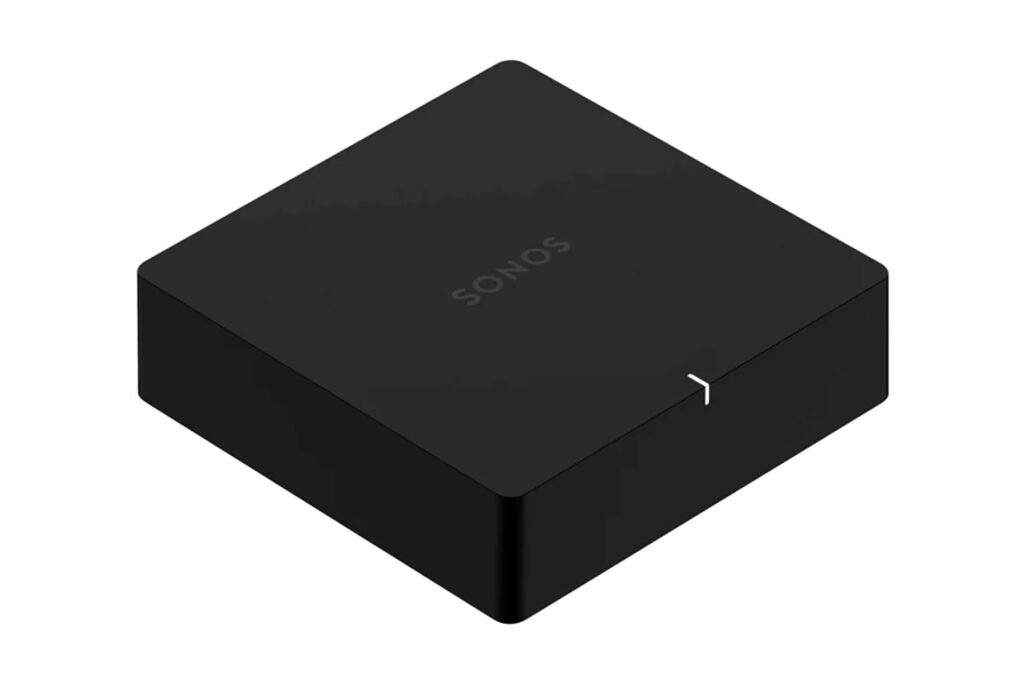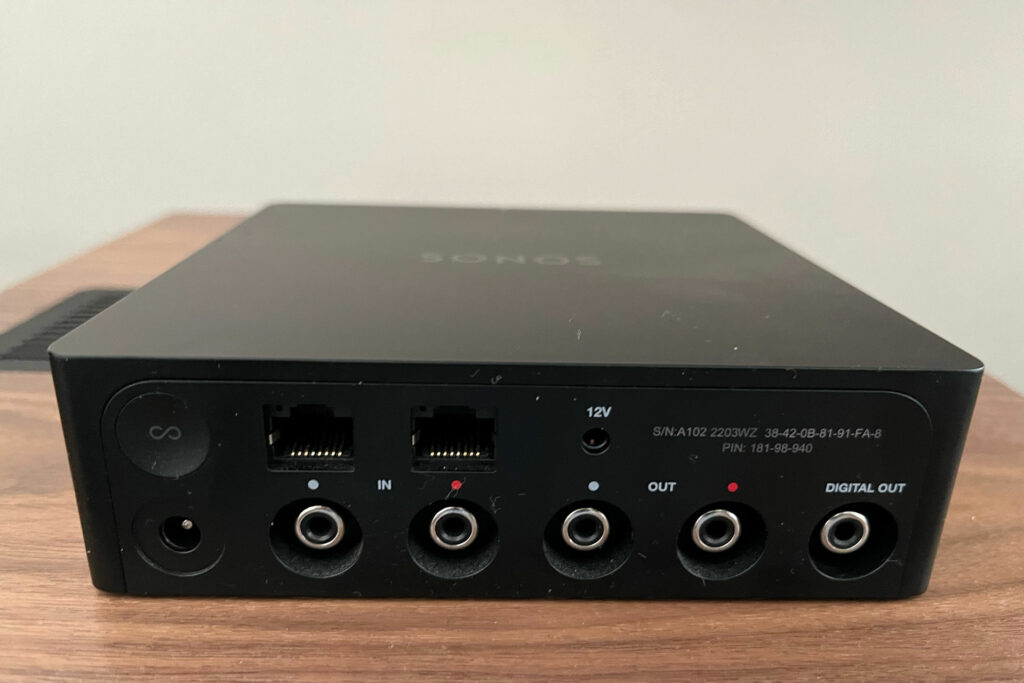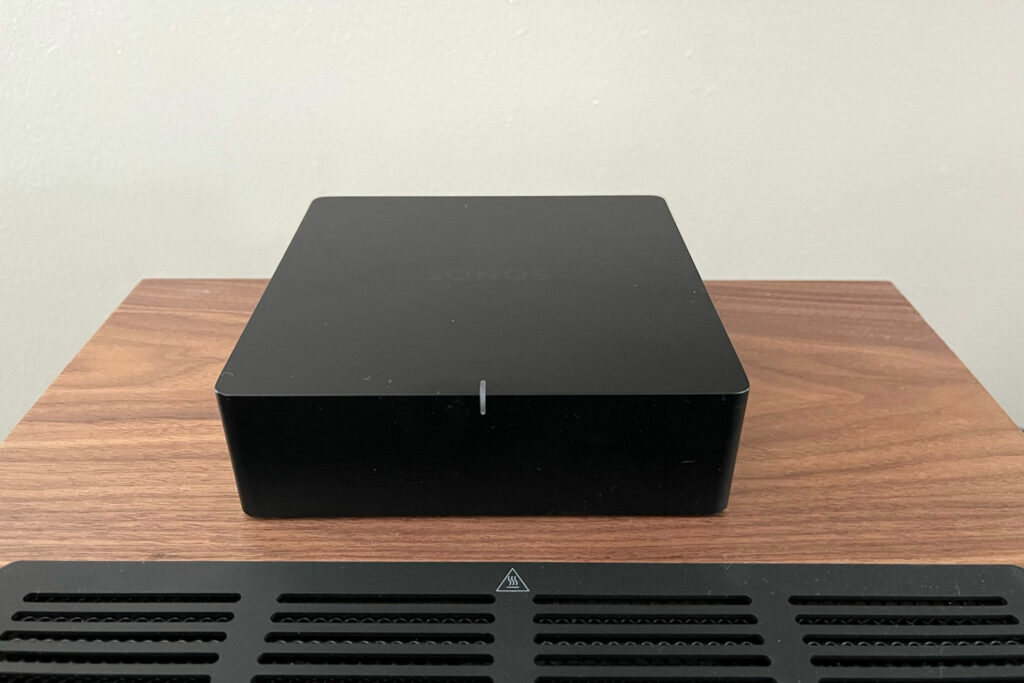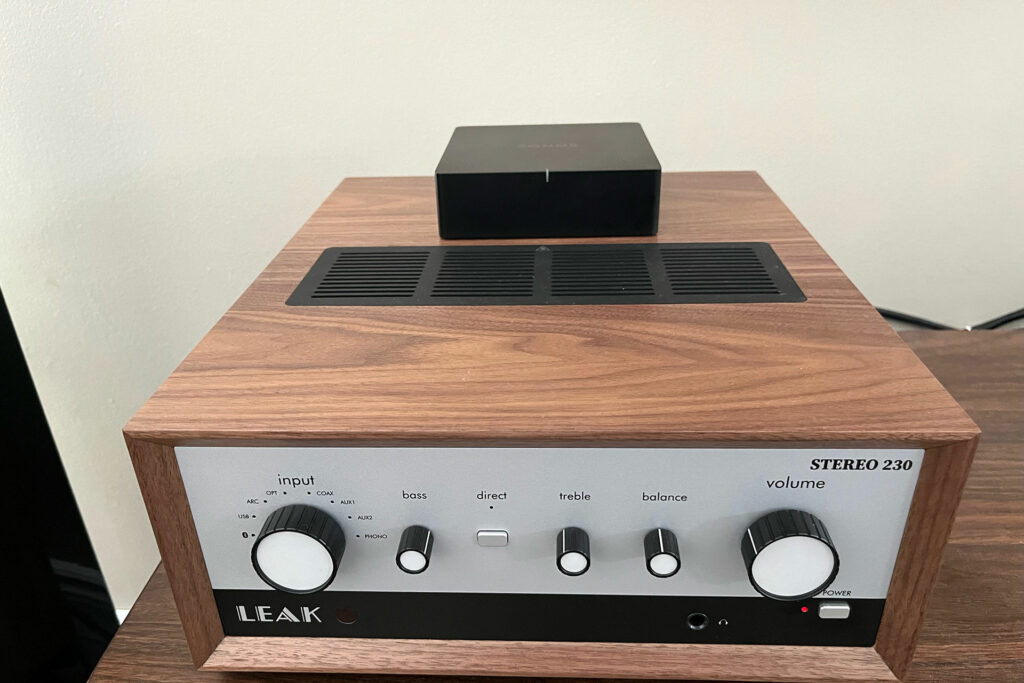Do you wanna know when an AV company is the real deal? Some might say that it is when they are sold in Best Buy or Magnolia stores, and that’s a good standard. Before Sonos made that distribution leap, they did something else wild, which is to advertise on the Super Bowl. While the ad was pretty obscure in its message, the idea that over 100,000,000 people would have exposure to your brand and/or product concept is a big brand statement. Sonos has never looked back, as they have changed the game for distributed audio forever with their MESH network-based, easy-to-setup, low-cost (as well as low dealer margin) family of speakers, amps and products like the Sonos Port endpoint (buy at Crutchfield – $449).
Paul Wilson has the most expensive audiophile system of anyone on staff at just under $500,000 total invested. While Sonos isn’t part of that specific system, every bit of sound in the rest of his gorgeous home is powered by Sonos. I personally have nine (yes, nine) legacy Sonos endpoints all racked up in my Middle Atlantic rack, thus feeding each zone of my home with unique audio. Some of those zones have invisible speakers from Nakymatone ECHT paired with nearly impossible-to-see Gray Sound S80 subwoofers that get room correction via an Anthem MDX-8 distribution amp that makes for a close-to-perfect-performing system in rooms where you can’t see a single audio component or speaker driver. That’s a cool trick, even if hardcore audiophiles would scoff at the concept. Nearly every other reviewer at FutureAudiophile.com has some form of Sonos, be it a Port or a soundbar or some product from the company. That’s saying something for the importance of the brand Sonos, even in this small, tech-crazy audiophile hobby.
The goal of this review is to look at the $449 Sonos Port as an audiophile endpoint. I call it an endpoint, because you can’t easily or directly import music into the unit. Unlike most endpoints, which rely on other operating systems, Sonos has their own OS, which is simply fantastic. Their interface with other music streaming companies is the best in the business, but you can’t import your own music into Sonos easily, as you can with a component that is more of a music streamer. How can a new audiophile integrate Sonos into their music-first audiophile system? This is where we start with this review…

What Makes the Sonos Port So Special?
- The operating system for Sonos (most endpoints rely on others’ OS) is simply fantastic. When I say fantastic, I mean Apple level of fantastic. Better than Kaleidescape fantastic. Sonos’ OS is rock-solid. While like any other product in its class, it needs an occasional software or firmware update, the Sonos Port is a rock-solid component.
- The Sonos Port communicates with all of the streaming platforms or providers better than any other endpoint or music server that I’ve tested. Companies like Sonos need to work with the likes of Amazon, Apple, Tidal, Qobuz, Pandora, Spotify and countless others in order to deliver a great user experience. Sonos delivers the best, most easy-to-use user experience of any of the players out there, including the Bluesound BluOS operating system, which is what I am using more now today than other components.
- If you want to have a distributed audio system in your home, condo or apartment – all you need is a Sonos Port and a device like a phone or iPad. Their network delivers multi-room control of your devices or theirs. It doesn’t matter. If you want to play “Super Freak” in the dining room, kitchen and outdoors – simply select the song on the service of your choice and select the rooms. Then adjust the volumes accordingly on the Sonos App and you are set. If you want to turn the music off by the BBQ, that’s as easy as can be.
- A product like a Sonos Port allows a renter to NOT need to embrace the drywall saw, and that can be a big advantage. You can connect so many different products both from the Sonos product family or from your own AV journey (as I did with the Anthem amp and fancy invisible speakers, plus stealth in-ceiling subwoofers). You can set up a whole-home audio system in minutes in ways that won’t ultimately impact you collecting on your deposit for a rented home or apartment. For many just getting started in audio (and in life), this can be a big advantage.
- There is a suitable internal DAC in the Sonos Port with friendly filtering. There are also digital outputs, which I used the COAX to connect the Sonos Port to my Benchmark Media DAC3 B professional audio and audiophile DAC.
- The Sonos App is well-made and beyond easy to use. This is a must-have on your phone or tablet if you are doing anything with Sonos. They nailed it with their app, as it is robust in performance and easy for anyone in your home to use. My 73-year-old mother-in-law can do anything on Sonos via the app. It is THAT easy to use.
Why Should You Care About the Sonos Port Audiophile Endpoint?
At $449, this is a very low-cost way to bring any and every streaming platform into your life and have masterful control over said music source. Even if you didn’t use the Sonos Port for critical listening, I could see an audiophile using a Port for shopping and exploring new music, as well as using it as a front end to a whole-home music playback system that is easy to install and relatively low-cost.
Younger audiophiles will like the small form factor of the Sonos Port, as well as the no-drywall-saw concept, which was, for a generation, a starting point for any whole-home audio system.

Some Things You Might Not Like About the Sonos Port
- There is no 24-bit output in a world where most of today’s best streaming music services are capable of delivering HD audio. Why Sonos feels the need to dumb down the performance of such an excellent product is beyond me. It is as if you bought a new Volvo because of its safety. A Volvo can be a cool ride for sure, but if they limited the top speed to 65 MPH, you likely would have an even better safety record, but even here in California the speed limit is 70 on the freeways and some of us might want to go a little faster than that from time to time. The same goes for audiophiles, too. Even today’s lower-cost semiconductors are capable of 24-bit performance, and in the volume that Sonos would purchase them, there is no excuse for having no way to get 24-bit audio out of a Sonos Port.
- You can’t import your own music easily into the Sonos Port. While the Port has its own awesome OS, you can’t plug a USB-A 1 terabyte thumb drive in the back of your Port and import your music, as you can with, say, a Bluesound Node music server at the same cost. There are other ways that you might be able to backdoor your music into your Sonos, such as through Apple Music, but that’s not as direct or high-resolution as how the Node and other more expensive audiophile music servers do things.
- The small form factor of the Sonos Port makes it like many other endpoints, a little awkward or odd in your rack. Are there cool, custom installation options for Sonos in a rack? Yes, and I use them with my older Sonos endpoints, but for audiophiles, there is value in having a bigger box. You can deliver a better power supply for one, but that likely isn’t relevant to Sonos’ core client, who isn’t even close to an audiophile.
- There are color options on the Sonos, if black alone is considered an option. The past unit was also available in white, and didn’t look so plain on its own or neatly installed into a rack. A little bit of flair in the industrial design of the Sonos Port would have gone a long way. Apple does it. Kaleidescape does it. Why can’t Sonos make a nicer-looking unit other than a half-rack-width blacker-than-black component? You will have to ask them, because they only offer black.
Listening to the Sonos Port Audiophile Endpoint…
I listen to Sonos in every room of my house. With their portable speaker, you can listen to your music literally anywhere that you take a portable (Sonos) speaker and your phone. For my audiophile listening, I used the Sonos Port mainly up against the Bluesound Node Music Server (buy at Crutchfield), which has the same cost. The digital output (COAX) was used into an $1,895 Benchmark Media DAC3 B digital to analog converter and into an Anthem STR stereo preamp (analog in). For power, I used a Pass Labs XA-25 Class-A, Nelson Pass-designed audiophile power amp that lit up a pair of $28,000 Bowers & Wilkins 802 D4 floorstanding loudspeakers. This is a little bit of an extreme setup for a normal Sonos setup, but when do we shy away from an extreme setup? That would be never.
While not HD whatsoever in terms of streaming sources (although it almost was before Sirius XM bought them), I still like Pandora for its ability to build playlists. One of the pre-made and well-curated lists is their Thievery Corporation Radio “station,” which not only pulls music from the Washington D.C.-based, trip-hop DJs, but also pulls material that fits right into that style of music. From Saudade which is one of their releases from 2014, the song “Decolage” is a jazzy, groovy female vocal track that has a sexy musical appeal. With the Sonos analog outputs in use (RCA – the unit is not balanced thus no XLRs) the internal DAC inside of the Sonos Port was better than expected. The filtering used in the Sonos’ internal DAC provided an enjoyable but a bit glossed-over sound, as compared to the digital-out version. With the COAX cable running into the studio-grade Benchmark DAC3 B digital to analog converter, you could hear a lot more of what was streaming from Pandora, and it wasn’t all good. The bass was more tight-sounding, but the piano wasn’t was friendly, as it had a little bit more bite to the sound than with the internal DAC. The imaging was notably better with the very fancy DAC in place, but the overall sound was more exposed for what it was. That’s how the Benchmark DAC rolls, as it doesn’t filter or mask anything, and when you got down to listening with the volume matched and set at CD resolutions, you could hear some of the shortcomings of the Sonos. When playing CD-level files from the Bluesound Note in the same exact system setup, the musical coherence was better. It sounded more complete or more together.
When comparing an HD file to the Sonos Port, you’ve can see how you’ve brought a gun to a knife fight sonically. I’ve been listening to the all-time classic Rumours from Fleetwood Mac. This is one of the Mt. Rushmore albums in the audiophile world, and the recording (featured in the killer Dave Grohl documentary, Sound City, which outlines how Grohl bought and revived the ultra-famous Rupert Neve console that Rumours and Nevermind were recorded on) is available in HD for streaming. When listening to “Gold Dust Woman” on the Bluesound Node with its best output, versus the Sonos Port’s best output, I had to take a hard gulp, as the Bluesound Node simply torched the Port sonically. The layering of the vocal harmonies was so much smoother and more appealing from Amazon Music in HD on the Node. The attack on some of the more atmospheric guitar pluckings was head and shoulders better on the Node. Simply put, everything sounded better, just as it is more fun to drive 90 on the freeway than 60. In the case of the Node versus the Port, you are talking about the same exact cost with both products having mainstream distribution, meaning you could take one home from a Best Buy or Magnolia store from any major city in the country.
Will the Sonos Port Hold Its Value?
Relatively speaking, you aren’t going to lose your ass on a Sonos Port, because so many people could use one or two (or nine, like me). They will always sell for a respectable price on, say, eBay.com but with a product that starts at such a reasonably low price, there isn’t much room for the unit to depreciate before it has no value. There are so many things that you can do with a Sonos Port outside of the audiophile space, I am betting that you would never have a good reason to sell a Sonos Port, but even if you did, you likely will do OK on the transaction, even if it gets you $100 or so back as the unit would owe you nothing at that point.

What Is the Competition for the Sonos Port from an Audiophile Perspective?
The NAD CS-1 (buy at Crutchfield) is a $349 endpoint that is a little bit simpler than the the Sonos Port, but more serious audiophiles could connect their laptop (complete with their ripped music collection) wirelessly to an NAD CS-1 via Apple Airplay 2 or Google Chromecast and have a good experience. I was able to do some listening between the Sonos Port and the NAD CS-1, which I just took out of my rack a few days ago, as it needed to go to another reviewer. As I mentioned before, I liked the analog output of the Sonos Port perhaps more than connecting it to a revealing, high-performance audiophile DAC. The NAD CS-1 was comparable sonically, but I might give the Sonos the slight edge here for non-HD (CD level) files. For HD files, the NAD CS-1 was better, but not as excellent-sounding as the Bluesound Node. Both the NAD CS-1, and the Sonos Port doesn’t allow you to import music directly into either endpoint.
The Bluesound Node at $449 (buy at Crutchfield) is priced at the same level as the Sonos Port, but sonically, is it superior. While you can do many of the same whole-home audio concepts with the Bluesound Node and its BluOS, it isn’t as good as the Sonos on that front. The HD musical performance, the very good but somewhat buggy interfaces with other streaming services outlines the value proposition for the Bluesound Node, but when you can take a $69 thumb drive and plug it into the back of the Node and have a huge collection of your music right there, this product is going to be more appealing to audiophiles. Factor in HD audio output, and the sale is done for most audiophiles.

Final Thoughts on the Sonos Port…
The Sonos Port is a very capable endpoint for music and could be used by entry-level audiophiles and be enjoyed enthusiastically. Where the Sonos Port shines is as the front end of a whole-home, distributed audio system, and what audiophile doesn’t want that in the rest of their home? We all want that, and many of us already have it, as Sonos is a disruptive player and a market-maker in that space.
Sonically, the Sonos Port is a good-sounding product, but not great by today’s audiophile standards. It does allow an audiophile to explore new music across more streaming platforms with few bugs or API issues than another endpoint out there, and that is a specific value.
Is there a place for a Sonos Port in your audiophile system? That is a question that only you can answer. I own nine of the earlier units and love them dearly. I have run the Sonos Port into my audiophile system in the past for beyond easy-to-use access to music, but sonically, as my system has grown, I now need more performance – specifically resolution. Do I love Sonos as a client and a concept? I sure do, and that’s not likely to change any time soon.
Sonos Port Music Streamer/Endpoint FAQ
What is the point of a Sonos Port?
The Sonos Port is an endpoint that allows you to add the Sonos music streaming experience to a non-Sonos music system. Sonos isn’t an app per se. It needs hardware to work in an AV, home theater or audiophile system. The Sonos Port is that component.
How do Custom Installers feel about Sonos?
As of 2025, custom installers have widely abandoned the Sonos platform because Sonos has “bricked” their products (leaving them worthless/useless) with software updates ONE TOO MANY times for the CI world.
This is a sad outcome in that Sonos, despite is very low dealer profit margin, was a darling of the CI world for years until their all-time, historic bad software rollouts.
Do Audiophiles use Sonos?
This is a tricky question.
Yes, audiophiles tend to use Sonos but NOT normally in their audiophile systems. The might setup a distributed music system using Sonos but you rarely see a Sonos Port fronting a $1,000,000 audiophile system or anything like it.
Is Sonos better wired or wireless?
Sonos works great wirelessly but ANY AV product benefits from a wired connection as they are almost always more reliable.
With that said, Sonos works with a MESH network making its own wireless connection which has many logistical benefits.
What other music streaming solutions to people look at instead of Sonos?
BlueSound is popular with our readers. Some type of connectivity. Same price. Great integration with PSB, NAD and Dali products.
HEOS is the Denon/Marantz version of Sonos that was so tempting that Apple stole the technology from medical services company, Masimo, resulting in a huge lawsuit.




Sonos: BAD product support.
I love their user interface.
I’ve had chat support with them that has worked out pretty well. I am finding that More and more than Chat support is sometimes faster/better although I like talking to actual people most of the time.
Calling the Port an audiophile product is a joke and it really calls into question your credibility as a reviewer and in fact the credibility of this entire site if they would allow such nonsense to be published. Sonos doesn’t even use the term audiophile on their own website and of the 500+ customer reviews on the Sonos website, only two use that term and both say it is explicitly NOT an audiophile component.
I work for a Sonos dealer and we sell a LOT of Sonos products to people whose kids or nephews told them they had to get Sonos. BUT we have performed multiple blind comparisons of the Sonos Port (and its predecessor, the Connect) against competitors from Bluesound, NAD, Marantz, McIntosh, Mark Levinson, HiFi Rose, Aurender, and others and almost every single time, the alternate was overwhelmingly preferred by every participant over the Sonos. It’s really quite sad. And while an external DAC can make the Port sound better, you could just spend more on any of the others I mentioned and get better performance AND usually a better app experience as well.
Jason,
Dude – did you read the review?
Seriously – did you read before you posted?
We are an audiophile site. Having audiophile keywords in our titles is just good SEO. If you read the review you’d understand how Sonos fits into the audiophile landscape. And if you can’t see how that works then perhaps we need to have a talk. For example: I have 9 Sonos end points to run my whole home audio system. NINE. That’s how it is done in the CI world these days. I also have a Bricasti DAC and end point plus a BlueSound Node 2024 for my audiophile system. There’s a place for all
It is likely that you’ve never sold a $600,000 audiophile system. Most haven’t. Paul Wilson, my colleague here, has one. He also uses Sonos all over his home.
You missed the point buddy. Sonos has THE BEST user interface in the business. Only as snobby ass OK Boomer print magazine would dismiss that when comparing streamers. I did that with the Lumin D2 for $2,500. What interface was better? THE SONOS by a LONG LONG LONG SHOT. Does it have ESS DAC chips in it? No but the comparison for people in the real world who might come and help us GROW THIS HOBBY are goning to want to know the difference.
(In deference to Jeff Bridges) Dude, Yes, I did read the article, I mentioned adding a DAC bc you spoke of that in your review. And SEO optimization is not justification for a scummy click-bait headline in my opinion. Curiously, the word “Audiophile” primarily appears in your review headlines on what are pretty much NON-audiophile equipment like Wiim, Sonos, and the cheap NAD CS-1. Actual audiophile gear doesn’t seem to warrant your supposed “SEO” trickery. Sure there’s one Bricasti review with it, but that’s all I saw.
And I don’t want to enter into a d**k measuring contest with you, but my company has sold multiple two-channel systems in excess of $600k and beyond. Our lead salesperson was the #1 Sonus Faber salesman in the country in 2023, having sold many pairs of Aidas and dozens of others down the line, typically with McIntosh MC901s or MC2Ks. And we have sold multiple Wilson Alexxes and Alexandrias over the years. We have also hosted events with Michael Fremer, Karen Sumner, David Wilson (RIP), Peter McGrath, and many others in an effort to build the hobby.
My company has also completed multiple CI projects on land and sea in excess of $2M, and we have sold systems with 20, 24, and even 32 Sonos Ports in them, so you can put that in your pipe and smoke it, too. We use Sonanace 8-130 or LEA 168 amps bc they sound better and are more rack-dense than using Sonos Amps. As far as user interface … do you actually use your Sonos system? I have Sonos in my Garage with two model Ones and a Sub and it’s a bit of a s**t show. The old Sonos app was good. S2 was bad, and this new one is an abomination. If I use the Sonos app to turn the music on, then I can’t use Google voice to turn it off (Google mutes the music, says nothing is playing, then resumes the music). And Google voice quit working altogether on my son’s Sonos One last month and the only way to fix it was to use an iPad to reconfigure it bc both my Pixel phone and Galaxy tablet would error out. The rest of my house runs on Bluesound and it works great. My wife hates the Sonos app with a passion, but can actually use the Bluesound app. Once Josh.ai starts supporting Bluesound, there will be no more need for Sonos in my house.
You mentioned Lumin. We used to sell those. They sounded great, but their app was a trainwreck (Levinson’s was somehow even worse). Aurender’s app is really good, so is Bluesound. And of course Roon can pull them all together in one big happy family … except Sonos. Sonos is still an island even if you have Roon. Because contrary to what you may believe, Sonos is NOT helping to grow the hobby. It is not a gateway drug, it is an endgame for most people, and you calling it an Audiophile device only legitimizes that endgame thought for those people.